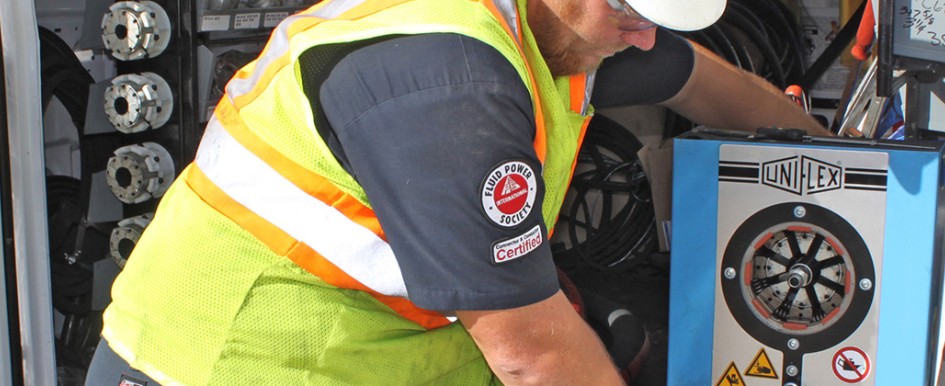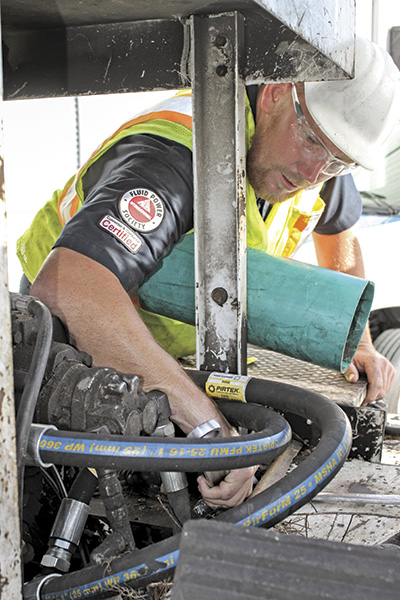
Hydraulic hoses keep heavy equipment and machinery working properly year-round. All hydraulic hoses break down, but following a few best practices will extend their life and keep machines working longer and more efficiently.
Hydraulic hose failure is typically attributed to three issues: site damage, wear and tear and contaminated oil in the hydraulic system.
Exposed hoses can easily get struck, severed or crushed by outside objects, such as sharp pieces of steel, concrete or rebar, which causes site damage. When equipment is working in an aggressive environment, such as a scrap yard or a construction site, there is typically an increased amount of site damage.
When the exterior of the hose assembly has been exposed to the elements, wear and tear will occur. The length of time the machinery or equipment is in service also plays a big role in wear and tear of hydraulic hoses. Ultraviolet light can cause the outer, protective cover to become hard, start to crack and fall away. This exposes the steel-wire reinforcement to the elements, which then rusts and eventually leads to hose failure.
Failure to replace hose brackets or clamps during the maintenance of other parts on the piece of equipment, thus exceeding the number of cycles which the hose assembly was designed to carry out or leaving the hose assembly free to rub against parts of the equipment, are also common causes of wear and tear. The life of a hydraulic hose is often measured by the number of times the system cycles.
Contamination failures occur when other parts of hydraulic systems start to break down. For example, these fragments could enter the oil and may not be big enough to be captured by the filter units, but are still large enough to create abrasion of the inner liner. Other causes can include opening the hydraulic system to simply refill the oil, which allows particles to contaminate the system. Several steps that can be taken to avoid hose failure and reduce downtime are listed below.

By regularly inspecting your equipment, you will be able to identify any external damage or cuts to the outer cover. When damage is detected, replace these hoses and consider adding a protective textile or a metal sleeve to protect the hose assembly before the equipment goes back into service. Taking preventative maintenance measures is much cheaper than an unexpected hose failure.
Consider ways to reduce breakdowns caused by wear and tear. Using a checklist with images during routine maintenance is a great start to making sure everything is working properly. Look for hoses that are rubbing in their clamps, dampness behind the ferrule, rust or oxidization of the fittings, cracked or missing covers and exposed wire reinforcements.
An easy way to reduce contamination is by following the manufacturer's recommendations regarding the life cycle of components and changing oil and filters. Keeping the hydraulic system clean through regular oil samples will help identify problems much more quickly. In some applications, there is a valid argument to place an additional filtration unit into the hydraulic system to maintain a low particle count.
Selecting a suitable vendor to oversee a company's hydraulic-hose assemblies is a crucial step. Good vendors understand that cutting a hydraulic hose with a saw, using metal blades or abrasive wheels, generates a significant amount of heat. The heat will cause rubber dust and metal particle contaminants to stick to the hose tube as it cools. Use a vendor that promotes using matched fittings. This means that the vendor should use hoses and fittings from the same manufacturer or a suitable combination. Hose assemblies that have been mixed and matched without proper testing can lead to early failure. Also, make sure that the fittings have been impulse tested to the correct SAE requirements.
Preventative maintenance should be at the forefront of a company's routine. Hire a hose provider that believes in cleaning and tagging hoses with a wide range of contamination control options. Following these tips will keep equipment running properly and save time and money.



